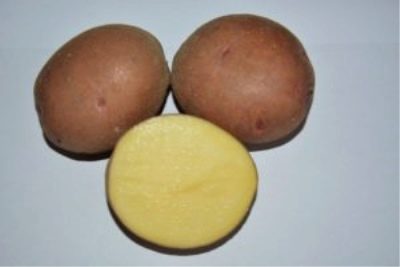
- Appointment: dining room
- Tuber size: large
- Peel color: red
- Color of the pulp: yellow
- Starch content,%: up to 15.2%
- Consistency: medium friable
- Tuber shape: rounded
- Peel structure: mesh
- The soil: effectively uses the natural fertility of the soil
- Flowers: red-purple
Pershatzvet potato is another excellent example of the work of Belarusian breeders, presented in an extensive list of indisputable successes. New varieties created in recent years are suitable not only for cultivation in all regions of the republic. Due to their optimal biochemical characteristics, they are suitable for cultivation in temperate regions, in areas with long cold winters and short cool summers. Pershatzvet is an early ripening variety, fruitful and virus-resistant.
Breeding history
Pershatzvet potatoes are a worthy continuation of the glorious traditions of breeding the dominant culture of agriculture, laid down in Soviet times. SPC NAS RB for potato and horticultural production recently announced new varieties obtained by painstaking work of breeders. They bred a number of varieties, among which Pershatzvet is one of the most popular, although there are others, no less productive, of different ripening periods, with tubers, the taste of which will satisfy the most picky gourmet.
Description of the variety
The variety is classified as a canteen: this means that it is suitable for any culinary need. In addition to useful features that are always inherent in Belarusian potato varieties, Pershatzvet has its own distinctive characteristics:
- resistance to common diseases and relative immunity to rot: fusarium and watery, late blight and viruses;
- early ripening of tubers (an excellent parameter for the first digging);
- the ability to maintain a presentation for a long time;
- resistance to mechanical damage during transportation, presentable appearance and large tubers.
Peculiarities of Pershatzvet - rapid accumulation and early ripening of root crops, high yield, resistance to common potato diseases. However, there are still undeniable arguments - excellent taste and suitability for cooking any dishes from the usual menu of the food mentality of a temperate climate.
Characteristics of the appearance of the bush and root crops
Medium-sized bushes are covered with a moderate amount of dark green leaves; during the flowering period, compact, but decorative corollas of a beautiful purple-red color appear on them. The netted red skin with shallow superficial eyes hides the yellow flesh with an optimal starch content (about 15%). Fruits are oval, large (150-200 g), small are rare. Seed material for the next year is rather difficult to collect (planting is carried out with tubers 35-55 mm).
Purpose and taste of tubers
Root crops belong to the AB category, which means that they have a moderate density pulp that does not turn black during heat treatment, with a slight indicator of wateriness. Suitable for any cooking method: from winter salads to frying, boiling, freezing as part of assorted mixes. In some sources it is called a dining room, in others it is called universal. There are no contradictions only in the description of taste: everyone agrees that Pershatzvet is beautiful in any form.
Maturation
Despite the short period of time for reaching the state of ripeness (from 60 to 70 days), the first digging can be carried out in 45 days, since the variety is characterized by fast and amicable ripening of tubers. Signs of readiness are standard: drying of the tops with an initial decrease in vegetative mass. After that, 12-14 tubers are found in each hole.
It is noted that due to the early harvest time, potatoes are rarely grown for winter storage. It is ideal for use for your own needs and for commercial profit (due to keeping quality and the ability to carry transportation over long distances).
Yield
In the southern regions, you can get two harvests per summer, but in more severe climatic conditions Pershatzvet beats all records. The average figure is 65 t / ha, the maximum is 67.8 t / ha.
Growing and caring
Unpretentiousness, the ability to grow on light and medium soils, to respond to any additional feeding with an increase in production are noted by all farmers working with potatoes. It is possible to accelerate the ripening period by preliminary heating and germination of seed material, timely moderate watering, top dressing before flowering, fruiting and planting. The cultivar responds gratefully to weed removal and hilling.
It is not recommended to use large tubers for planting, the planting depth is standard. The gardener will be pleased with the rapid accumulation of the crop already in the first half of the growing season, and proper agricultural technology can increase the standard number of tubers in the hole or their weight.

Planting potatoes is one of the main spring activities traditional for Russian gardeners. There are many ways to plant this vegetable, allowing you to get a good harvest in different conditions and climates. Before planting, you need to carefully prepare the planting material, correctly determine the timing, competently prepare the soil.




Potatoes are a popular vegetable crop that many gardeners planted on their site. But growing a bountiful harvest of tasty and large tubers is unlikely to succeed if the beds are not properly protected from the most common diseases and pests. Often, the development of diseases of various etiologies of potatoes goes unnoticed, so it is important to identify the problem in time and eliminate it.
















































































